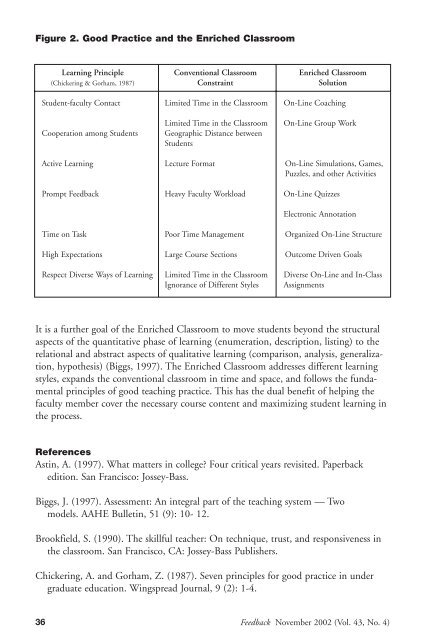Figure 2. Good Practice and the Enriched ClassroomLearning Principle Conventional Classroom Enriched Classroom(Chickering & Gorham, 1987) Constraint SolutionStudent-faculty Contact Limited Time in the Classroom On-Line CoachingCooperation among StudentsLimited Time in the ClassroomGeographic Distance betweenStudentsOn-Line Group WorkActive Learning Lecture Format On-Line Simulations, Games,Puzzles, and other ActivitiesPrompt <strong>Feedback</strong> Heavy Faculty Workload On-Line QuizzesElectronic AnnotationTime on Task Poor Time Management Organized On-Line StructureHigh Expectations Large Course Sections Outcome Driven GoalsRespect Diverse Ways of Learning Limited Time in the Classroom Diverse On-Line and In-ClassIgnorance of Different Styles AssignmentsIt is a further goal of the Enriched Classroom to move students beyond the structuralaspects of the quantitative phase of learning (enumeration, description, listing) to therelational and abstract aspects of qualitative learning (comparison, analysis, generalization,hypothesis) (Biggs, 1997). The Enriched Classroom addresses different learningstyles, expands the conventional classroom in time and space, and follows the fundamentalprinciples of good teaching practice. This has the dual benefit of helping thefaculty member cover the necessary course content and maximizing student learning inthe process.ReferencesAstin, A. (1997). What matters in college? Four critical years revisited. Paperbackedition. San Francisco: Jossey-Bass.Biggs, J. (1997). Assessment: An integral part of the teaching system — Twomodels. AAHE Bulletin, 51 (9): 10- 12.Brookfield, S. (1990). The skillful teacher: On technique, trust, and responsiveness inthe classroom. San Francisco, CA: Jossey-Bass Publishers.Chickering, A. and Gorham, Z. (1987). Seven principles for good practice in undergraduate education. Wingspread Journal, 9 (2): 1-4.36<strong>Feedback</strong> <strong><strong>No</strong>vember</strong> <strong>2002</strong> (<strong>Vol</strong>. <strong>43</strong>, <strong>No</strong>. 4)
Donald, J. (1997). Improving the environment for learning: Academic leaders talkabout what works. San Francisco, CA: Jossey-Bass.Gorham, J. (1999). Diversity in classroom dynamics. In A. Vangelisti, J. Daly, and G.Friedrich, Eds. Teaching communication: Theory, research, and methods. Pp. 257-268. Mahwah, NJ: Lawrence Erlbaum Associates, Publisher.Jackson, S. and Madison, C. (1999). Instruction by design: Technology in yhrdiscourse of teaching and learning. In A. Vangelisti, J. Daly, and G. Friedrich,Eds. Teaching communication: Theory, research, and methods. Pp. 393-408.Mahwah, NJ: Lawrence Erlbaum Associates, Publisher.Keating, A. and Hargitai, J. (1999). The wired professor: A guide to incorporating theworld wide web in college instruction. New York, NY: New York University Press.Krendl, K., Warren, R. and Reid, K. (1997). Distance learning. In W. Christ,Ed. Media education assessment handbook. Pp. 99-119. Mahwah, NJ: LawrenceErlbaum Associates, Publisher.McKeachie, W. (1994). Teaching tips: Strategies, research, and theory for college anduniversity teachers. Lexington, MA: D.C. Heath.Oppenheimer, T. (1997). The computer delusion. Atlantic Monthly, July.Ruminski, H. and Hanks, T. (1997). Critical thinking. In W. Christ, Ed. Mediaeducation assessment handbook. Pp. 1<strong>43</strong>-164. Mahwah, NJ: Lawrence ErlbaumAssociates, Publisher.Strauss, J. and Frost, R. (1998). Learning objectives guide instructional technologymedia selection. Unpublished paper. American Marketing Association SummerConference.BEA—Educating tomorrow’s electronic media professionals 37
- Page 2 and 3: Feedback November 2002 (Vol. 43, No
- Page 4 and 5: CommentSWOT Analysis: Disney Consid
- Page 6 and 7: without adding enough people to do
- Page 8 and 9: his favorite questions for prospect
- Page 10 and 11: The intellectual satisfaction you
- Page 12 and 13: Finding qualitative evidence via te
- Page 14 and 15: 2 Using a two-tailed Pearson Correl
- Page 16 and 17: • We need to expand digital editi
- Page 18 and 19: Two final points: While this paper
- Page 20 and 21: 1. As elsewhere in the profession,
- Page 22 and 23: EvaluationThere will be approximate
- Page 24 and 25: CLASSROOMEMPHASIZING ETHICS: PROMOT
- Page 26 and 27: “Avoiding Plagiarism” ( http://
- Page 28 and 29: CLASSROOMMULTIMEDIA FOR MORTALS: RE
- Page 30 and 31: Video files come in a variety of di
- Page 32 and 33: CURRICULUMDISMANTLING THE SILOS: MO
- Page 34 and 35: the Web on deadline and conceptuali
- Page 36 and 37: CLASSROOMADAPTING DIGITAL LEARNING
- Page 38 and 39: strategies. Unfortunately, most tex
- Page 42 and 43: CLASSROOMSTUDENTS TACKLE SUPER BOWL
- Page 44 and 45: Usually, I urge students to use the
- Page 46 and 47: aggression with intelligence, when
- Page 48 and 49: e lost in sole reporting of undiffe
- Page 50 and 51: COMMENT“SCHOOL DAYS, SCHOOL DAYS,
- Page 52 and 53: CLASSROOMSWOT ANALYSIS: DISNEY CONS
- Page 54 and 55: analysis. SWOT is an acronym for St
- Page 56 and 57: Disneyland ResortDisney Vacation Cl
- Page 58 and 59: CURRICULUMDON’T ISOLATE E-BUSINES
- Page 60 and 61: mention implications from legal and
- Page 62 and 63: viable media alternative to televis
- Page 64 and 65: management are needed to deliver th
- Page 66 and 67: Humboldt, Chris (2000). How E-comme
- Page 68 and 69: editing is a place of influence. St
- Page 70 and 71: COMMENTYO, YO, YO! THIS IS THE HIP-
- Page 72 and 73: REVIEWSchroeder, Sheila E. (2002).
- Page 74 and 75: ANNOUNCEMENTS2003-2004 Scholarship
- Page 76 and 77: ANNOUNCEMENTSBroadcast Education As
- Page 78: NEWSJohn Mark DempseyUniversity of
















